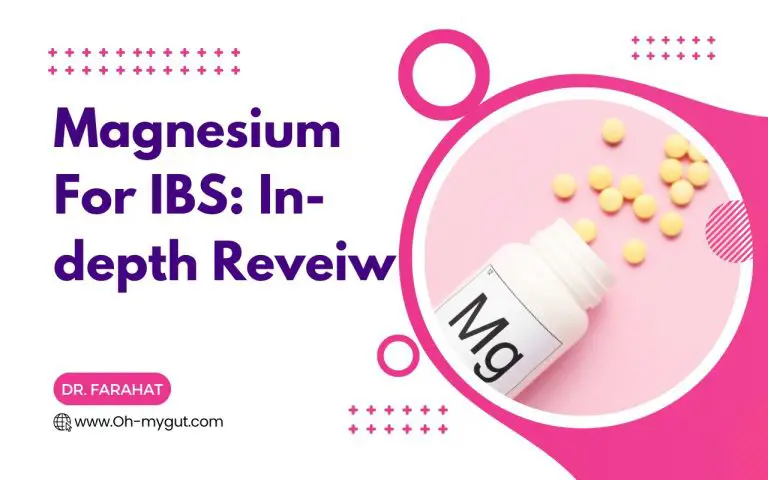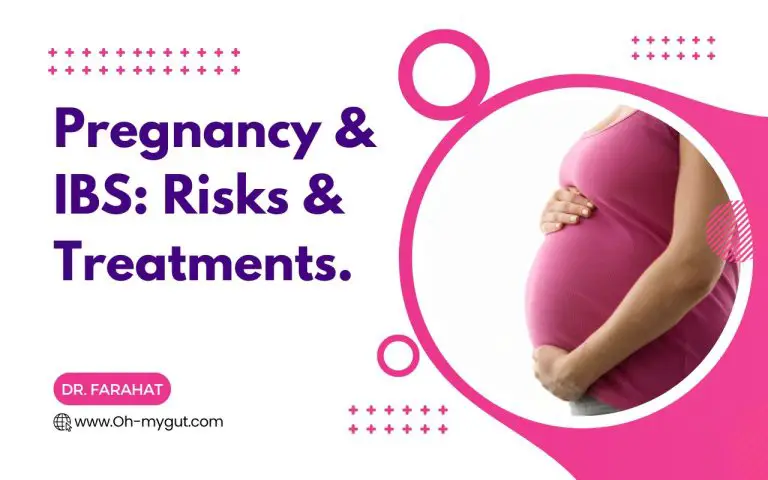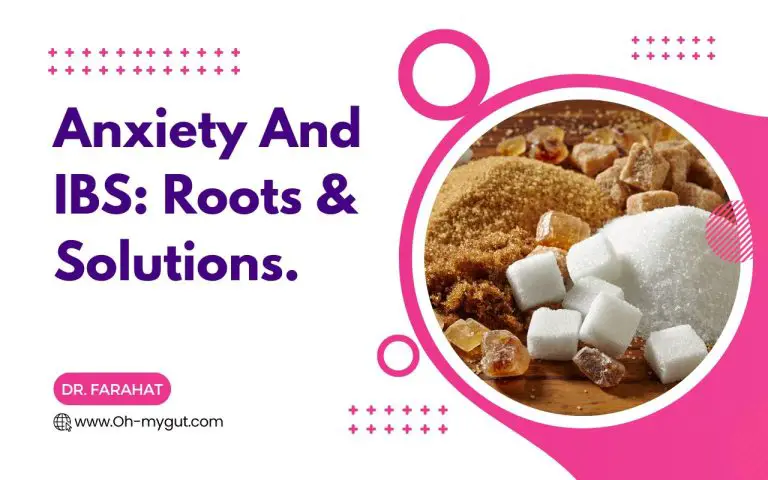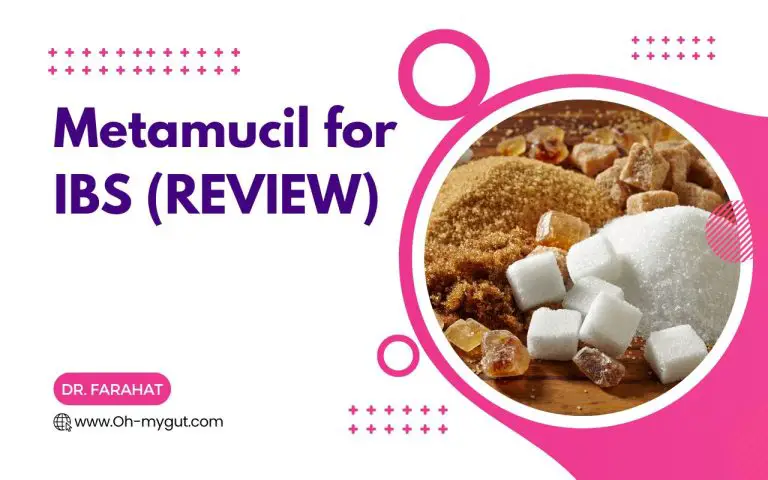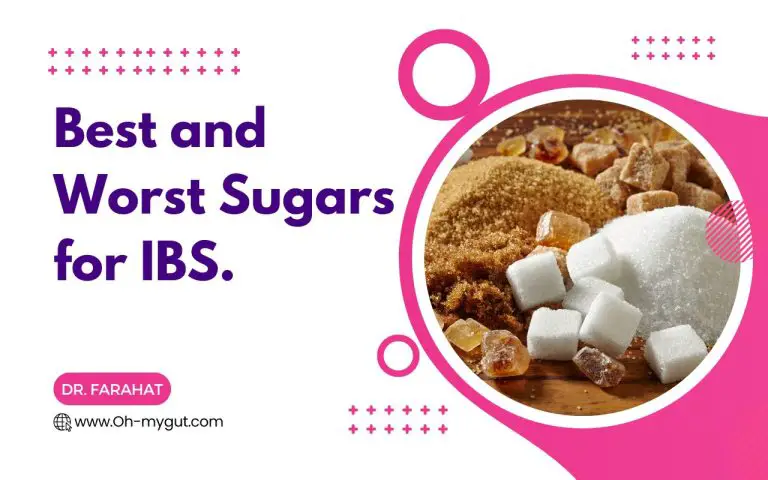Typical & Atypical IBS Pain Locations (Diagram Included)
Our content is not intended nor recommended as a substitute for medical advice by your doctor. Use for informational purposes only.
Hey there, fellow IBS warrior! If you’re like me and sometimes feel pain in places you wouldn’t typically associate with IBS, this article is for you. I will walk you through the usual and not-so-usual locations of IBS pain and how to tell the difference between IBS pain and other conditions based on where it hurts.
In 2004, Dr. Tally from the Mayo Clinic published a fascinating study with eye-opening results. After examining the health records of over 89,000 patients, Dr. Tally found that those with IBS were:
- Three times more likely to have had their gallbladder removed (a procedure known as cholecystectomy).
- Twice as likely to have had their appendix removed (an appendectomy).
- 50% more likely to have had back surgery.
These stats suggest that IBS can sometimes be misdiagnosed as a more serious condition like appendicitis or cholecystitis.
Abdominal pain can be one of the most perplexing medical conditions regarding diagnosis and treatment. Even today, no single lab test or imaging study can definitively diagnose IBS. Doctors mainly rely on abdominal pain and its relationship to meals and bowel movements to diagnose IBS.
But here’s the thing: abdominal pain isn’t specific to IBS. Almost all diseases that occur inside your abdomen can also cause abdominal pain. So, understanding IBS pain locations, triggers, and characteristics is crucial for an accurate IBS diagnosis.
Before we start, Here is a table summary of all possible IBS pain locations (typical and atypical) and possible confused conditions in each of them:
| Pain Location | Typical/Non-Typical | Possible Confused Conditions |
|---|---|---|
| Around the Belly Button (Umbilicus) | Typical | Early appendicitis, Umbilical hernia, Gastric ulcer, IBD, Pancreatitis |
| Under the Ribs (Epigastric Area) | Typical | Heartburn/Indigestion, Hiatus hernia, Gastric or duodenal ulcer, Hepatitis, Cholecystitis |
| Lower Abdomen (Middle) | Typical | Cystitis, Prostatitis, IBD, Pelvic/Menstrual pain, Inguinal Hernia |
| Lower Left Abdomen (Left Iliac Pain) | Typical | Chronic constipation, IBD, Right ovarian or right fallopian tube problems, Inguinal Hernia |
| Under the Ribs on the Right Side (Right Hypochondrial Pain) | Typical | Biliary colics and cholelithiasis, Acute hepatitis, Abdominal and chest wall pain on the right side, Duodenal and stomach ulcers |
| Under the Ribs on the Left Side (Left Hypochondrial Pain) | Typical | Functional dyspepsia, pain from gastritis or stomach ulcers, Pancreatitis |
| Kidney Areas (Right and Left) | Typical | Kidney stones, Kidney inflammation or infection, IBD, Chronic constipation, Muscular Pain |
| Back (Backache) | Non-Typical | Spine-related conditions |
| Headaches and Migraines | Non-Typical | Tension headaches, migraines, etc. |
| Pelvic Pain | Non-Typical | Dysuria, Painful intercourse, Pelvic problems |
| Chest Pain | Non-Typical | Gastro-Esophageal Reflux Disease (GERD), Cardiac conditions |
| Pain in Joints (Fibromyalgia Syndrome) | Non-Typical | Osteoarthritis, Vitamin D deficiency, etc. |
[I] The Usual Suspects: Typical IBS Pain Locations and Characteristics
IBS pain usually hangs around the belly button (umbilicus) and lower abdomen. The most common locations are:
- Around the belly button,
- In the upper central part of the abdomen (the epigastric or stomach area),
- In the lower abdomen (especially the lower left side).
But here’s the kicker: IBS pain can pop up anywhere in the abdomen and even in places outside your abdomen!
Check out the diagram below, which I’ve adapted from the Journal of Gastroenterology and Hepatology. It shows the most common typical IBS pain locations.
The diagram below is acquired with modification from the “Journal of Gastroenterology and Hepatology” explaining the common, typical IBS pain locations.
The numbers below give you an idea about the most common IBS pain areas (with #1 being the most common and #7 being the least common):
- Around the belly button: the most common, affecting 39% of patients.
- The second most common is in the upper central part of the abdomen, affecting 33% of patients.
- In the lower central abdomen: affecting 13% of patients.
- In the lower left abdomen: affecting about 7% of patients. 5, 6, and 7 are less common locations.
Remember, these numbers are approximate. Other studies have shown slightly different distributions of IBS pain.
Other Clues That Suggest Your Pain Is Due to IBS:
According to the Rome IV criteria, IBS pain is:
- Related to meals: IBS pain usually increases, especially after eating known food triggers like FODMAPs and gas-producing foods.
- Related to bowel movements: Some people with IBS report relief from pain after a bowel movement. Others report that their IBS pain worsens during or after a bowel movement.
- Frequent: IBS pain is chronic, meaning you should have first experienced it at least six months ago. It should occur at least once per week.
- Crampy or colicky: IBS pain is often described as cramps or colics, usually associated with bloating and gas.
- Associated with changes in stool character: Yellow stool (with IBS-Diarrhea), Mucus in stool, and Hard stools (with IBS-constipation).
[II] Red Flags: Features Suggesting That Your Pain Is NOT IBS Pain
(1) Severe, stabbing abdominal pain:
Pain from inflamed organs inside your abdomen, like appendicitis or cholecystitis, is usually very severe. It’s associated with severe pain when pressure is applied to the affected area of your abdomen.
Example: Severe, stabbing pain under the ribs in the right upper part of the abdomen, accompanied by severe nausea, may indicate cholecystitis, an inflammation of your gallbladder usually caused by gallstones.
(2) Continuous Pain:
Continuous pain is different from colicky pain. Continuous pain starts to increase gradually without breaks.
Continuous pain occurs with conditions like:
- Inflamed organs inside your gut, chest, or pelvis (e.g., appendicitis, pelvic abscess, hepatitis).
- Bone, rib, vertebrae, and joint pain (like hip joint pain).
- Abdominal wall (muscles or skin) pain.
On the other hand, IBS pain is colicky. This means that IBS pain occurs in waves or cramps (lasting seconds to minutes), followed by partial relief from pain.
Example: Pain in the upper central part of your abdomen (epigastric area) that gradually increases after meals to a steady intensity for hours may suggest gastritis.
(3) Pain that’s related to movement:
Movement-related pain is the kind that:
- Greatly increases with even a tiny movement like sitting or leaning forward, and
- It is nearly relieved when you maintain a fixed position and stop moving.
IBS pain usually stays the same whether moving or in a fixed position. Movement-related pain occurs with other conditions like inflamed organs, bone, and joint pain.
Example: Pain in the lower right part of your abdomen that greatly increases while you move your right lower limb may suggest appendicitis.
(4) Pain that’s not related to meals:
IBS pain usually gets worse after meals. If your pain is of the same intensity regardless of your meals, it may suggest conditions other than IBS.
Example: Severe abdominal colic and diarrhea occurring several times, even hours after your last meal, may suggest gastroenteritis, an intestine infection by bacteria or other intestinal pathogens.
(5) Pain that wakes you up from sleep:
Typical IBS pain doesn’t wake you up after you’ve fallen asleep. “Nocturnal pain” and “nocturnal diarrhea” are not features of IBS.
Example: A woman with lower left abdominal pain that interferes with sleep and is unrelated to meals may have a problem with her left ovary or left Fallopian tube.
(6) Pain that’s associated with:
- Fever: Fever usually suggests an infection or inflammation inside your gut.
- Vomiting: Vomiting is not a feature of IBS. But IBS is commonly associated with GERD (Gastro-Esophageal Reflux Disease), which may be the cause. Other common causes of vomiting are gastritis, gastric ulcers, early pregnancy, cholecystitis, chemotherapy, and others.
- Blood in stool: If you have blood in your stool with IBS, you should immediately consult your doctor. Bloody stool may indicate various conditions, ranging from simple hemorrhoids to dangerous conditions like colon cancer. You can learn more about this topic here.
- Other “red flag” signs: In addition to the above, you should consult your doctor if you experience:
- The onset of IBS pain after the age of 50.
- Progressive weight loss.
- Presence of iron deficiency anemia.
- If you have a family history of colon cancer or IBD (Ulcerative Colitis or Crohn’s Disease).
[III] Typical IBS Pain Areas
IBS pain can pop up anywhere in your abdomen, but it can also show up in places outside your gut, like your back and pelvis. Let’s dive into both the common and uncommon IBS pain areas, and I’ll also mention other conditions that can mimic IBS pain.
(1) IBS Pain Around The Belly Button (Umbilicus)
IBS pain is most common in the lower abdomen, especially around the belly button. Here’s what typical IBS pain in this area looks like:
- It’s colicky, meaning it comes in waves of contractions (usually seconds to minutes) followed by periods of partial relief.
- It’s associated with bloating and gas.
- It usually increases after meals.
- It’s related to bowel movements – it may be relieved or worsen during or after you poop.
- It’s recurrent but not progressive, meaning you experience it at least once weekly for the previous three months. There are usually periods of remission and flare-ups (IBS attacks).
If your pain progresses (increases daily, week after week), you should consult your doctor.
Other conditions that can cause pain around the belly button include early appendicitis, umbilical hernia, gastric ulcer, IBD (Inflammatory Bowel Disease), and Pancreatitis.
(2) IBS Pain Under the Ribs (Epigastric Area)
This is another common IBS pain location. IBS is often associated with GERD (Gastro-Esophageal Reflux Disease) and Functional Dyspepsia. Pain from these conditions is usually constant, progressively increasing after meals, unrelated to bowel movements, and may be associated with vomiting & heartburn.
Other conditions that can cause pain in the mid-abdomen under the ribs include heartburn/indigestion, hiatus hernia, gastric or duodenal ulcer, hepatitis, and cholecystitis.
(3) IBS Pain in the Lower Abdomen (Middle)
This is also a common IBS pain location, but it can be confused with a variety of other conditions:
- Cystitis: an infection of the urinary bladder usually associated with a change in urine color, painful urination (dysuria), and frequent urination of small amounts. Cystitis is more common in females.
- Prostatitis: This occurs only in males, especially those older than 50. It may be associated with fever, abnormal urinary secretions, and difficult urination.
- IBD (Inflammatory Bowel Disease).
- Pelvic/Menstrual Pain (in females): a common form of pain misdiagnosed as IBS. Pain from the uterus, fallopian tubes, or ovaries may resemble IBS. The pain is exclusively in the lower abdomen and lower back and has little relation to meals and bowel movements.
- Inguinal Hernia.
(4) IBS Pain in the Lower Left Abdomen (Left Iliac Pain)
Some studies suggest the left iliac region is the most common IBS pain location. If your IBS pain occurs in this location, it’s usually relieved by bowel movements. Left lower abdomen IBS pain is more common with IBS-Constipation (IBS-C).
But IBS pain in the left lower abdomen can be confused with other conditions like chronic constipation, IBD, right ovarian or right fallopian tube problems (in females), and inguinal hernia.
(5) IBS Pain Under the Ribs on the Right Side (Right Hypochondrial Pain)
IBS pain can occur under the ribs on the right side, but this area is also where the liver and gallbladder are located. The IBS pain is related to meals, is associated with bloating or gas distension, is related to bowel movements, and is crampy.
Other common causes of pain under the right ribs include biliary colics and cholelithiasis (gallstones), acute hepatitis, abdominal and chest wall pain on the right side, and duodenal and stomach ulcers.
(6) IBS Pain Under the Ribs on the Left Side (Left Hypochondrial Pain)
IBS pain on the left side is more commonly present in the left lower part of your abdomen. Less commonly, IBS pain occurs under the ribs on your left side. This area overlies the stomach, spleen, and pancreas.
IBS pain in this area can be confused with functional dyspepsia, pain from gastritis or stomach ulcers, and Pancreatitis.
(7) IBS Pain in the Kidney Areas (Right and Left)
IBS colics can occur all over your abdomen; the kidney areas are no exception.
IBS pain in the kidney can be confused with kidney stones, inflammation or infection, Inflammatory bowel disease, chronic constipation, and muscular pain (in the abdominal wall).
[III] Typical IBS Pain Areas
IBS pain can pop up anywhere in your abdomen, but it can also show up in places outside your gut, like your back and pelvis. Let’s dive into both the common and uncommon IBS pain areas, and I’ll also mention other conditions that can mimic IBS pain.
(1) IBS Pain Around The Belly Button (Umbilicus)
IBS pain is most common in the lower abdomen, especially around the belly button. Here’s what typical IBS pain in this area looks like:
- It’s colicky, meaning it comes in waves of contractions (usually seconds to minutes) followed by periods of partial relief.
- It’s associated with bloating and gas.
- It usually increases after meals.
- It’s related to bowel movements – it may be relieved or worsen during or after you poop.
- It’s recurrent but not progressive, meaning you experience it at least once weekly for the previous three months. There are usually periods of remission and flare-ups (IBS attacks).
If your pain progresses (increases daily, week after week), you should consult your doctor.
Other conditions that can cause pain around the belly button include early appendicitis, umbilical hernia, gastric ulcer, IBD (Inflammatory Bowel Disease), and Pancreatitis.
(2) IBS Pain Under the Ribs (Epigastric Area)
This is another common IBS pain location. IBS is often associated with GERD (Gastro-Esophageal Reflux Disease) and Functional Dyspepsia. Pain from these conditions is usually constant, progressively increasing after meals, unrelated to bowel movements, and may be associated with vomiting & heartburn.
Other conditions that can cause pain in the mid-abdomen under the ribs include heartburn/indigestion, hiatus hernia, gastric or duodenal ulcer, hepatitis, and cholecystitis.
(3) IBS Pain in the Lower Abdomen (Middle)
This is also a common IBS pain location, but it can be confused with a variety of other conditions:
- Cystitis: an infection of the urinary bladder usually associated with a change in urine color, painful urination (dysuria), and frequent urination of small amounts. Cystitis is more common in females.
- Prostatitis: This occurs only in males, especially those older than 50. It may be associated with fever, abnormal urinary secretions, and difficult urination.
- IBD (Inflammatory Bowel Disease).
- Pelvic/Menstrual Pain (in females): a common form of pain misdiagnosed as IBS. Pain from the uterus, fallopian tubes, or ovaries may resemble IBS. The pain is exclusively in the lower abdomen and lower back and has little relation to meals and bowel movements.
- Inguinal Hernia.
(4) IBS Pain in the Lower Left Abdomen (Left Iliac Pain)
Some studies suggest the left iliac region is the most common IBS pain location. If your IBS pain occurs in this location, it’s usually relieved by bowel movements. Left lower abdomen IBS pain is more common with IBS-Constipation (IBS-C).
But IBS pain in the left lower abdomen can be confused with other conditions like chronic constipation, IBD, right ovarian or right fallopian tube problems (in females), and inguinal hernia.
(5) IBS Pain Under the Ribs on the Right Side (Right Hypochondrial Pain)
IBS pain can occur under the ribs on the right side, but this area is also where the liver and gallbladder are located. The IBS pain is related to meals, is associated with bloating or gas distension, is related to bowel movements, and is crampy.
Other common causes of pain under the right ribs include biliary colics and cholelithiasis (gallstones), acute hepatitis, abdominal and chest wall pain on the right side, and duodenal and stomach ulcers.
(6) IBS Pain Under the Ribs on the Left Side (Left Hypochondrial Pain)
IBS pain on the left side is more commonly present in the left lower part of your abdomen. Less commonly, IBS pain occurs under the ribs on your left side. This area overlies the stomach, spleen, and pancreas.
IBS pain in this area can be confused with functional dyspepsia, pain from gastritis or stomach ulcers, and Pancreatitis.
(7) IBS Pain in the Kidney Areas (Right and Left)
IBS colics can occur all over your abdomen; the kidney areas are no exception.
IBS pain in the kidney can be confused with kidney stones, inflammation or infection, Inflammatory bowel disease, chronic constipation, and muscular pain (in the abdominal wall).
[IV] The Non-Typical IBS Pain Locations
The Rome criteria describe IBS Pain as abdominal pain. Other studies suggest that IBS may cause pain in atypical sites.
This “Non-typical” IBS pain may be in the back, chest, or pelvis. The evidence that IBS can cause extra-abdominal pain is still weak.
If you experience Painback, chest, or pelvis pain, you should discuss this with your doctor.
The potential non-typical IBS pain locations are:
(1) IBS Pain in the Back (Backache)
A study in the UK found that up to two-thirds of IBS patients complain of back pain. It’s common for IBS sufferers to experience back pain, which can lead to unnecessary orthopedic clinic visits and even unnecessary back surgery. If you have back pain with your IBS, you should consult your doctor about this relation, especially if the back pain increases during your IBS flare-ups.
(2) IBS Headaches and Migraines
You may experience headaches with your IBS, as headaches are more common in IBS patients than in the general population. Some reports suggest headaches are more common in patients with IBS constipation. Also, migraines are related to IBS. One of the manifestations of the “aura” of a migraine is abdominal pain, which means that a migraine may cause IBS abdominal pain.
(3) IBS Pelvic Pain
IBS is related to a variety of painful symptoms originating from the pelvis. Examples include painful or difficult urination (dysuria), painful intercourse in females (dyspareunia), and IBS flare-ups more frequently during menses in females. Some people with IBS describe pain in the buttocks, hips, groins, testicles, and scrotum during IBS attacks. If you feel pain in any of these locations, you should discuss it with your doctor. IBS does not necessarily cause it and may reflect a pelvic problem.
(4) IBS Pain in the Chest
IBS is commonly associated with esophageal diseases like Gastro-Esophageal Reflux Disease (GERD), which may cause non-cardiac chest pain. Unlike cardiac chest pain, chest pain due to IBS is unrelated to exercise. But you should immediately consult your doctor if you have chest pain and you are a male, older than 40 years old, a smoker, have a family history of cardiac disease, or if your pain is related to exercise.
(5) Fibromyalgia Syndrome (IBS Pain in Joints)
Fibromyalgia is a common disease (1% of the general population). Its actual cause is unknown. Fibromyalgia is a chronic disease. If you have fibromyalgia, you will experience pain in muscles, tendons, and joints. Some people with IBS describe pain in the hip bones, pain down the legs, and pain in the tailbone. This may reflect Fibromyalgia syndrome.
Several studies have related IBS to fibromyalgia. Some studies evidenced that IBS is very common among Fibromyalgia patients (50 to 80% of patients with fibromyalgia have IBS).
So if you have IBS and feel pain in joints or muscles, you should consider fibromyalgia and discuss this with your doctor.
Conclusion
IBS is a “syndrome” with various symptoms and pain areas. You may experience symptoms unrelated to IBS, like headaches, joint and muscle pain, dysuria, painful sexual intercourse, chest and back pain, and chronic fatigue. These symptoms may result from your IBS (but not always).
The typical IBS pain is abdominal, related to meals, and associated with a change in bowel habits. If you experience any of the abnormal pain characteristics below, you should see your doctor:
- Severe stabbing pain and tenderness in any area of your abdomen.
- Pain that is associated with vomiting or fever.
- Continuous pain that is not related to meals.
- Pain that awakens you from sleep.
- Progressively increasing pain with weight loss or anemia.
FAQs:
What is the most common IBS stomach pain location?
The most common location for IBS pain is around the belly button or umbilicus. However, pain can also frequently occur in the upper central part of the abdomen (epigastric or stomach area) and the lower abdomen, especially the lower left abdomen.
Is there a difference between pain locations between IBS-C (Constipation-predominant IBS) and IBS-D (Diarrhea-predominant IBS)?
The location of IBS pain can vary widely and is not necessarily specific to whether a person has IBS-C or IBS-D. However, some studies suggest that left lower abdominal pain is more common in IBS-C. It’s important to note that the location of the pain can vary from person to person and even from episode to episode in the same person.
Can IBS cause constant pain for months?
IBS is characterized by recurrent abdominal pain associated with bowel habit changes. While the pain can be chronic and persist for months, it typically comes and goes rather than being constant. The pain is often related to eating and may be relieved by bowel movements. you’reu’re experiencing constant pait’sit’s important to consult with a healthcare provider as this could indicate a different or additional condition.
Can IBS pain occur on one side (left or right)?
Yes, IBS pain can occur on one side, either left or right, or be more generalized. Some people with IBS report experiencing pain more frequently in the lower left side of the abdomen, but this can vary from person to person.
How painful is IBS (can the IBS pain be unbearable?)?
The severity of IBS pain can vary widely from person to person. Some people may experience mild discomfort, while others may have severe pain. Pain from IBS is often described as a cramping or aching sensation that comes and goes. you’reu’re experiencing severe or unbearable pait’sit’s important to seek medical attention as this could indicate a more serious condition.
- Evidence-based
- Written by a doctor.


